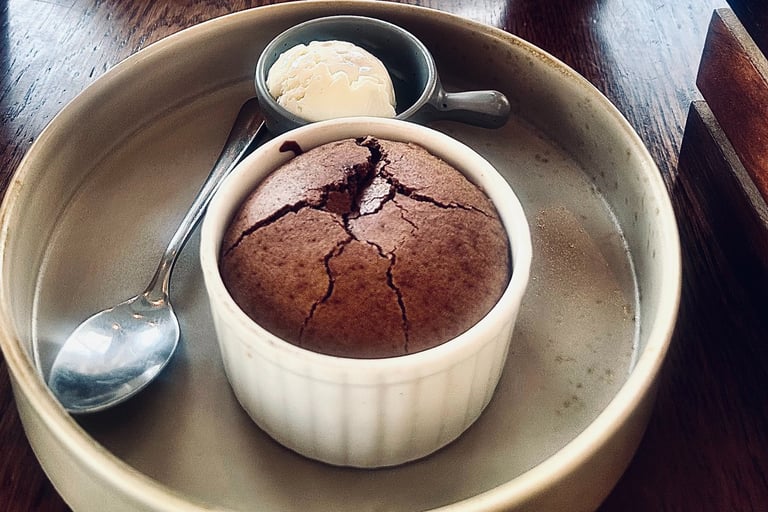Warm vs Cool Desserts Explained: The Temperature Tells the Tale
8/7/20255 min read


“In grapevine chemistry, every molecule has a purpose, and some have a punchline!”
Exothermic Eats vs Endothermic Treats
When discussing desserts, the concepts of exothermic and endothermic processes can provide fascinating insights into how temperature influences our culinary experiences. Exothermic desserts, which are typically warm, release heat to the surrounding environment while being consumed. This type of dessert often features comforting characteristics that play a crucial role in nurturing and providing a sense of warmth. Classic examples include molten chocolate cakes or freshly baked pies, where the warmth not only enhances the flavors but also creates a cozy atmosphere. The heat from these desserts can intensify sweetness and aroma, leading to a richer sensory experience.
On the other hand, endothermic desserts are characterized by their cooling nature. These treats absorb heat from their surroundings, offering a refreshing and rejuvenating experience. Items such as ice cream, sorbet, and chilled fruit salads exemplify this category. The coolness of these desserts can provide a stark contrast to the heat of a meal or the warmth of the surrounding environment. This temperature differential is particularly appealing on hot days, as it provides both relief and enjoyment. The sensation of cold can also heighten flavors and provide a crispness that is often associated with freshness and vitality.
The interplay between warm and cool desserts thus speaks to their distinct roles in our culinary enjoyment. While exothermic desserts can foster comfort and indulgence, endothermic treats serve to awaken our senses and refresh our palate. Understanding these dynamics not only enhances our appreciation for different dessert types but also influences our choices based on mood, season, and occasion. In the world of desserts, the temperature does indeed tell a compelling tale, guiding us toward the flavors and sensations we crave.
Featured Desserts: Strawberry Tres Leches and Choco Lava Cake
Strawberry Tres Leches and Choco Lava Cake are two exemplary desserts that capture the essence of contrasting temperatures and flavors. Each dessert possesses unique characteristics that not only delight the palate but also highlight the importance of temperature in culinary experiences.
Strawberry Tres Leches is a traditional Latin American dessert that is celebrated for its decadent, chilled, creamy texture. This luscious cake is soaked in a mixture of three types of milk: evaporated milk, sweetened condensed milk, and whole milk, which makes it incredibly moist and rich. Fresh strawberries are often layered throughout or garnished on top, providing a delightful contrast to the milky base. The cold serving temperature of this dessert accentuates its refreshing qualities, making it a popular choice for warm-weather occasions. When serving Strawberry Tres Leches, it is customary to accompany the dish with a dollop of whipped cream or a drizzle of strawberry sauce to enhance its visual allure and flavor profile.
In contrast, Choco Lava Cake encapsulates the essence of warmth with its signature molten chocolate center. This dessert is prepared by baking chocolate cake batter until the outer shell sets while the interior remains gooey and decadent. The warm, flowing chocolate center creates a delightful experience that contrasts beautifully with its firm exterior. Choco Lava Cake is often served hot, paired with a scoop of vanilla ice cream, which allows the heat to slightly melt the ice cream, enhancing the overall indulgence. The combination of temperatures creates a harmonious balance, elevating the dessert's flavors and textures.
By examining these two desserts, we can appreciate how temperature plays a pivotal role in enhancing their respective flavors and textures. Both Strawberry Tres Leches and Choco Lava Cake offer unique experiences that are sure to satisfy any dessert lover's cravings.
The Science Behind the Sweetness: Chemistry of Desserts
Understanding the chemistry involved in desserts is crucial for both amateur and professional bakers. Temperature plays a significant role in transforming simple components into delectable treats, influencing sugar crystallization, flavor release, and texture. The science behind warm and cool desserts begins with the behavior of sugar under varying temperatures. When heated, sugar melts and can undergo caramelization, resulting in complex flavors and an appealing brown color. This transformation enhances the taste of desserts like warm caramel sauce or toffee pudding, creating a rich flavor profile.
Conversely, when sugar is cold, it retains its crystalline form, contributing to the crunchy texture in desserts such as cookies or meringues. The equilibrium between sugar's melting and crystallization, affected by temperature, is pivotal in achieving the desired consistency and taste. In the case of gelato or ice cream, the freezing process not only solidifies the mixture but also impacts the flavor release, as colder temperatures can mute certain taste sensations.
Fat content in desserts also plays an essential role in texture and mouthfeel. Warm desserts often utilize butter or oils that, when melted, create a rich, decadently smooth texture. In contrast, in chilled desserts, fats solidify, providing a different sensation when consumed. Proper emulsification is vital for achieving a creamy texture in both types of desserts, leading to an enjoyable dining experience.
Moreover, flour and other binding ingredients interact uniquely with temperature. In warm desserts, heat causes proteins in flour to denature and form gluten, contributing to the structure and chewiness of baked goods such as bread or cakes. Alternatively, the absence of heat in cool desserts allows other ingredients like gelatin or starches to gel, providing stability and structure in delights like panna cotta or fruit jellies. Thus, the chemistry behind desserts reveals the intricate dance of ingredients on temperature, allowing for an exploration of flavors and textures that elevate the culinary experience.
When to Serve What? Pairing Desserts with Occasions
Selecting the appropriate dessert for a given occasion requires careful consideration of various factors, including the climate, season, and type of meal being served. Warm desserts, such as molten chocolate lava cake or bread pudding, often evoke feelings of comfort and coziness, making them ideal for colder weather or intimate gatherings. These desserts tend to pair beautifully with hearty meals, such as a roast dinner during the winter months, where their warmth complements the richness of the main course.
Conversely, cool desserts, like sorbet or fresh fruit tarts, shine during warmer months and are best suited for lighter meals. For instance, a refreshing citrus sorbet can cleanse the palate after a light summer lunch or a barbecue, providing a much-needed relief from the heat.
Another factor to consider is the occasion itself. Formal events may call for elegant plated desserts that not only taste exquisite but also add a visual appeal to the table. In such cases, a beautifully crafted panna cotta or a chilled mousse may be more appropriate than a rich, warm dessert, which could potentially feel heavy in a formal setting. On the other hand, casual gatherings can embrace the warmth and nostalgia associated with comforting baked goods, making a warm apple crisp or a chocolate brownie an excellent choice.
By pairing warm or cool treats with the right occasion or meal, one can turn dessert into a memorable finale, not just an ending.




Contacts
Socials
Subscribe to our newsletter
support@otgscience.in
Copyright © 2024 otgscience.in
.
